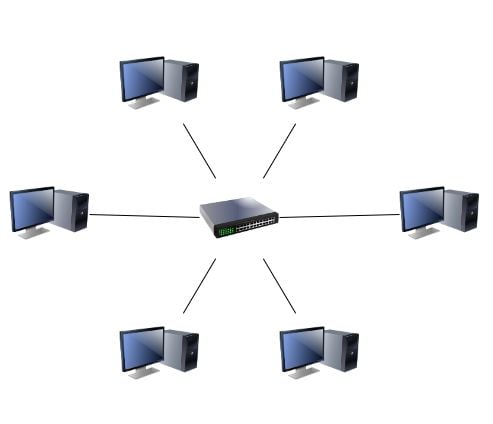A local-area network (LAN) is a computer network that spans a relatively small area. Most often, a LAN is confined to a single room, building or group of buildings, however, one LAN can be connected to other LANs over any distance via telephone lines and radio waves.
A system of LANs connected in this way is called a wide-area network (WAN). The difference between a LAN and WAN is that the wide-area network spans a relatively large geographical area. Typically, a WAN consists of two or more local-area networks (LANs) and are often connected through public networks.
Jump to:
- Nodes on a LAN
- Types of local area networks
- Deploying a wireless LAN
- Related Jobs: LAN Network Administrator
Nodes on a LAN
 Most LANs connect workstations and personal computers. Each node (individual computer) in a LAN has its own CPU with which it executes programs, but it also is able to access data and devices anywhere on the LAN. This means that many users can share expensive devices, such as laser printers, as well as data. Users can also use the LAN to communicate with each other, by sending email or engaging in chat sessions.
Most LANs connect workstations and personal computers. Each node (individual computer) in a LAN has its own CPU with which it executes programs, but it also is able to access data and devices anywhere on the LAN. This means that many users can share expensive devices, such as laser printers, as well as data. Users can also use the LAN to communicate with each other, by sending email or engaging in chat sessions.
LANs are capable of transmitting data at very fast rates, much faster than data can be transmitted over a telephone line; but the distances are limited and there is also a limit on the number of computers that can be attached to a single LAN.
Recommended Reading: Webopedia’s Network Topology Study Guide
Types of Local-Area Networks (LANs)
There are many different types of LANs, with Ethernets being the most common for PCs. Most Apple Macintosh networks are based on Apple’s AppleTalk network system, which is built into Macintosh computers. The following characteristics differentiate one LAN from another:
- Topology: The geometric arrangement of devices on the network. For example, devices can be arranged in a ring or in a straight line.
- Protocols: The rules and encoding specifications for sending data. The protocols also determine whether the network uses a peer-to-peer or client/server architecture.
- Media: Devices can be connected by twisted-pair wire, coaxial cables, or fiber optic cables. Some networks do without connecting media altogether, communicating instead via radio waves.
Deploying a Wireless LAN
Wireless networks are relatively easy to implement these days, especially when compared to the prospect of having to route wires when deploying a new wired network or overhauling an existing one. The first step in planning a wireless LAN deployment should be to decide on your wireless networking technology standard. Keep in mind that the standard you need to accommodate your network access points and routers as well as the entire collection of wireless network interface cards (NICs) for your computers and other network resources.
Recommended Reading: How Do I Deploy a Wireless LAN?
Related Jobs: LAN Network Administrator
The LAN network administrator is responsible for maintaining an organization’s local area network. In most cases, the LAN spans a single geographical site, such as a corporate office. A LAN network administrator’s job responsibilities include: installing LAN network components, tracking and renewing licenses for software and equipment, monitoring LAN performance, upgrading LAN network software and hardware, creating network redundancy and backups to ensure continuity in the event of network failure, and installing software and hardware to ensure local area network security.
What is a LAN Adapter?
A popular and technology phrase is the LAN adapter. This is the most common and generic alternate name for a Network Interface Card (NIC). Today, similar products, such as a Wireless USB LAN Adapter or a Wii LAN Adapter is also called a LAN adapter.
UPDATED: This page was updated April 2021 by Web Webster.

